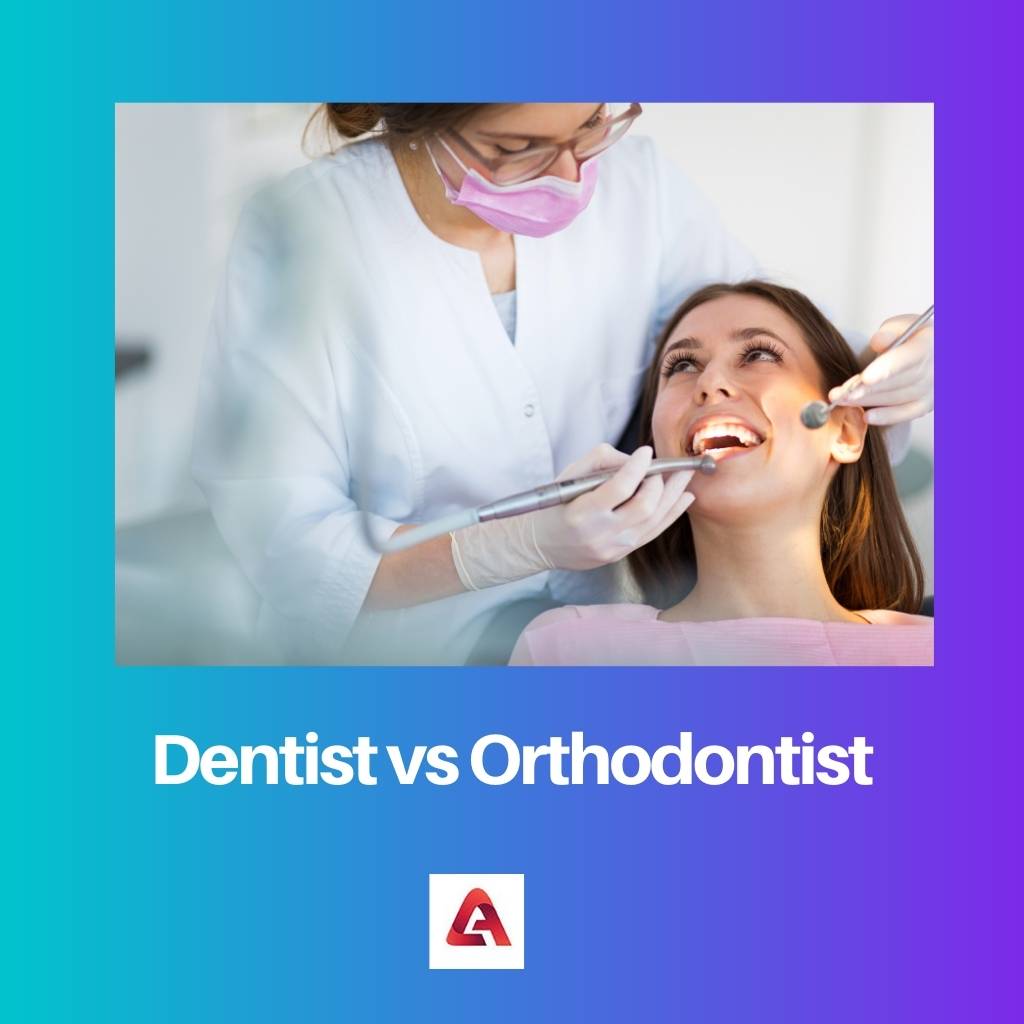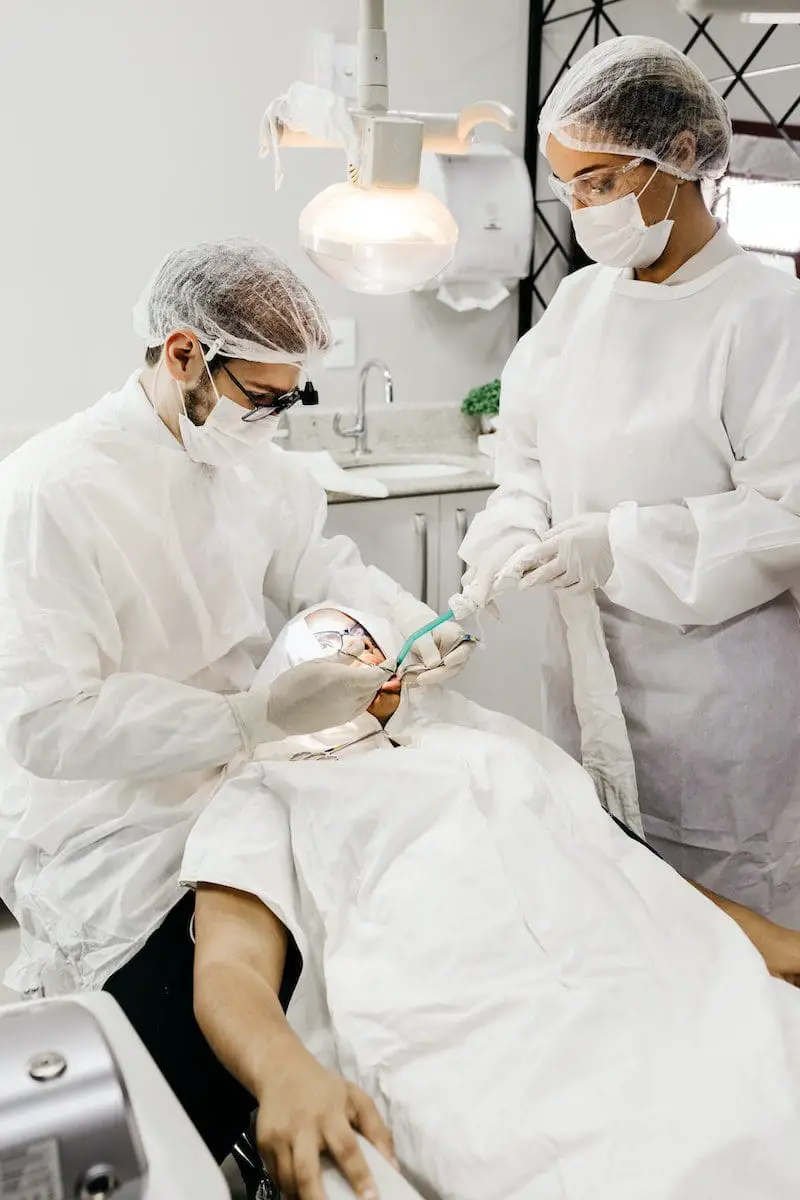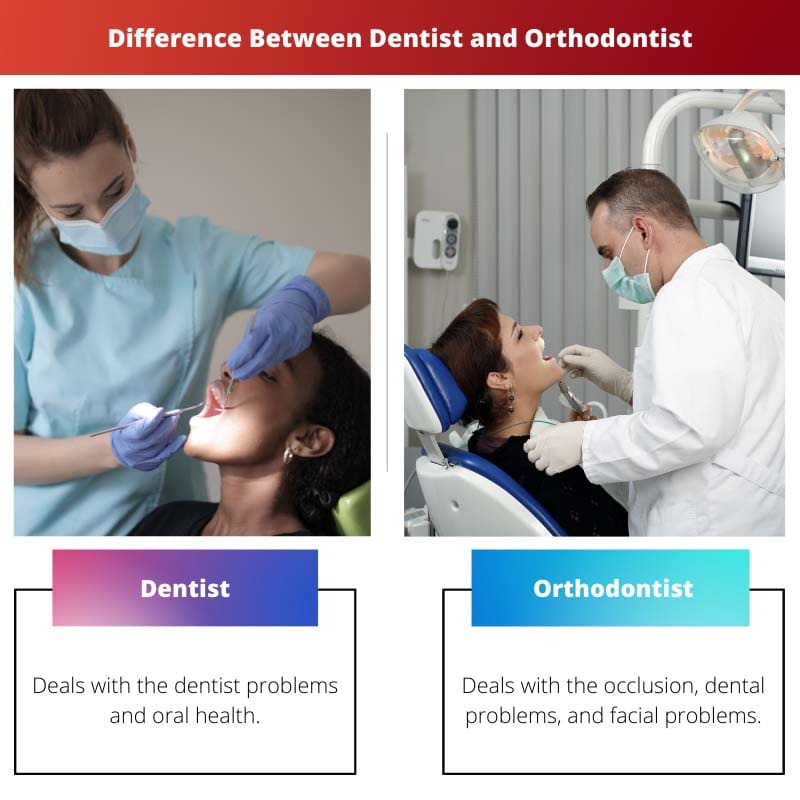People around the world may get sick or feel low and to cure that many doctors and specialists are available around the corner. People study for years to become a doctor, and it requires much hard work to do so.
Different body parts require different specialist doctors to treat the diseases. Some of them are – Orthodontists (specialists in teeth), cardiologists (specialists in the heart), ENT specialists (expertise in ear, nose, and throat), gynaecologists (specialists in female reproductive health), and many others.
Key Takeaways
- A dentist is a healthcare professional who treats oral health issues, while an orthodontist specializes in correcting misaligned teeth and jaws.
- A dentist provides general oral care services like fillings and cleanings, while an orthodontist provides specialized services like braces and aligners.
- A dentist only requires additional training beyond dental school, while an orthodontist needs additional training to become certified.
Dentist vs Orthodontist
The difference between a Dentist and an Orthodontist is that a Dentist deals with the individual’s teeth, gums, nerves, and jaws, whereas comparatively. An Orthodontist is a specialist and deals with the correction of bites, straightness of an individual’s teeth, and occlusion. Both work in the improvement of the oral health of the individual.

The dentist is an individual who studies dentistry, diagnosis, and prevention. These are the doctors that are specialists in their work, and their team involves – dental technicians, dental assistants, dental hygienists, and sometimes therapists who are also present or associated with them.
Modern dentistry considers Pierre Fauchard as the father who published the first-ever book on the techniques and practices.
An orthodontist is an individual that also deals in the dentistry field, diagnoses different diseases and problems, then cures them and suggests their prevention for the future.
Specifically, they are specialists in curing the alignment of the teeth and curing the wrong-aligned jaws and bite patterns. The orthodontist also deals with the modification of facial growth, which is also called a dentofacial orthodontist.
Comparison Table
| Parameters of Comparison | Dentist | Orthodontist |
|---|---|---|
| What are they? | Deals with the dentist problems and oral health | Deals with the occlusion, dental problems, and facial problems |
| Education | Dental degree | Dental agree and special orthodontist degree |
| Deals In | Diagnose and treat the problems or diseases that occurred in teeth or gums | Tooth and Jaw alignment |
| Specialist | In all teeth or gum related problems | In orthodontist |
| Prescription | Only general dental care | All orthodontic treatment |
What is Dentist?
A dentist is an individual who is also specialized in treating problems related to teeth or gums in the mouth. They help in promoting good hygiene and various good health practices for the mouth that helps in preventing problems or diseases related to teeth or gums.
Thus, by following the practices advised by doctors, one could prevent many diseases or problems.
To become a specialized dentist an individual must complete his/her bachelor’s degree in dental science, followed by additional written and practical exams. The students pursuing a degree in dentistry are also advised with a compulsion to practice under supervision for some time.
Nowadays, the increase and improvement in technologies have bought many new medical instruments in dentistry. A doctor can perform an X-ray of the mouth, lasers or drills can be used, scalpel, brush, and much other equipment are used.
Many safety types of equipment, like glasses, gloves, surgical masks, etc., are used by doctors to prevent the spread of bacteria and germs.

What is Orthodontist?
An orthodontist is an individual who is also a specialist in curing facial irregularities. They also diagnose, prevent, and help in curing the dental problems of an individual.
The treatment ranges of an orthodontist are somewhat limited as they are only known best for treating cracked tooths, fixing bad bites, and aligning the wrong jaw.
To become an orthodontist, one must have to complete a bachelor’s degree in dental along with a specialization in orthodontics degree. The bachelor’s program itself takes 4 years long to complete, and additionally, an approximate hard work of additional 5000 hours is appreciated.
An orthodontist’s major work is to treat the misalignment of the tooths and cure them with braces or with the nowadays popular substitute of braces clear aligners.
They also treat the bad habits of the children from childhood, like – the movement of the tooth because of sucking the thumb in the mouth. It also helps in treating sleep apnoea, the zig-zag pattern of the teeth, etc.

Main Differences Between Dentist and Orthodontist
- A Dentist is an individual that deals in the field of oral health and cures dentist problems and oral health, whereas comparatively, on the other hand, an Orthodontist is an individual that also deals in the field of oral health but special in occlusion, dental problems, and facial problems.
- The education qualification required for becoming a dentist is the normal bachelor’s degree in the field of dentistry, whereas comparatively, on the other hand, the education qualification required for becoming an orthodontist is a normal bachelor’s degree with a specialization in orthodontist degree.
- The dentist is an individual that helps in treating all the problems related to teeth or gums in the mouth, whereas comparatively, on the other hand, the orthodontist is an individual that helps in treating all the orthodontic problems like – tooth or jaw alignment.
- A dentist is specialized in providing treatment to all tooth or gums-related problems or diseases, whereas comparatively on the other hand, an orthodontist is an individual who is specialized in the treatment of all the orthodontic-related problems of the mouth.
- A dentist can prescribe treatment or cure related to all the general tooth or gums-related problems to every age group, whereas comparatively, on the other hand, an orthodontist can prescribe treatment and cure related to every orthodontic-related problem faced by the individual.

- https://meridian.allenpress.com/angle-orthodontist/article/53/3/240/56045/Long-Term-Stability-of-Dental-Relationships-After
- https://onlinelibrary.wiley.com/doi/abs/10.1111/j.1708-8240.1999.tb00414.x

The detailed descriptions of the roles and responsibilities of dentists and orthodontists are enlightening. It showcases the depth of expertise required.
Indeed, the information provided highlights the vast range of skills and specializations within oral health care.
The comprehensive overview of the functions of dentists and orthodontists is very insightful. It’s clear how much knowledge and precision is involved in their work.
The emphasis on the prevention and treatment of oral health issues by dentists and orthodontists is impressive. It highlights their dedication to patient care.
Absolutely, the focus on holistic care and prevention is a key aspect of dentistry and orthodontics.
The commitment to preventative oral health practices by these professionals is commendable and essential for maintaining overall well-being.
The historical and modern context provided for dentistry and orthodontics is thought-provoking. It shows the evolution and significance of these professions over time.
The descriptions of the roles and responsibilities of dentists and orthodontists are very thorough and informative. It provides clarity on the significance of these professions in healthcare.
I agree, the expertise of dentists and orthodontists is crucial for the maintenance of oral health and well-being.
I appreciate the detailed explanation of the education and training that dentists and orthodontists must undergo. It really highlights the expertise needed to work in these fields.
I agree! It’s clear that both dentists and orthodontists must have a lot of knowledge and experience to effectively treat oral health issues.
The rigorous training and education required for these professions are a testament to the complexity and importance of oral health.
The explanation of the differences between dentists and orthodontists is very informative. It helps to distinguish the specific areas of focus and expertise in oral health care.
Absolutely, the clarity provided on the unique roles of dentists and orthodontists is valuable for understanding the breadth of oral health care.
The detailed overview of the distinctions between dentists and orthodontists provides a comprehensive understanding of oral health care specialties.
The historical context provided about the development of modern dentistry is fascinating. It shows the long history of innovation and advancement in these fields.
Absolutely, the contributions of key figures like Pierre Fauchard have had a lasting impact on modern dental practices.
The breakdown of the roles of dentists and orthodontists in treating oral health is very informative. It’s helpful to know the distinction between these fields.
Absolutely, understanding the differences between dental and orthodontic care is essential for patients seeking the right treatment.
The information on the educational pathways for dentists and orthodontists is very comprehensive. It underscores the depth of training required for these professions.
I agree, the level of education and specialization for these fields is quite extensive and not to be overlooked.
The commitment to high-quality training for dentists and orthodontists is evident. It sets a standard for excellence in oral health care.
The comparison table provided is very clear and makes it easy to differentiate between dentists and orthodontists. It’s helpful for those who may be unfamiliar with the distinctions.
I agree, the comparison table is a great tool for understanding the specific focus areas of dentists and orthodontists in oral health care.